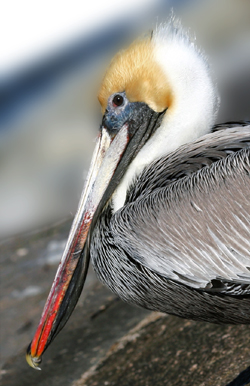There is something prehistoric about the Brown Pelican. With its pterosaur beak -- equipped with a fish-toting pouch three times the size of its belly -- the Pelican seems a visitor from the age of dinosaurs. And in 1963, the American Brown Pelican nearly followed dinosaurs into extinction, with only about 100 birds left in the Gulf of Mexico -- the result of DDT, harassment by fisherman, and destruction of nesting grounds. The Brown Pelican was among the first birds protected by US environmental legislation in the 1970's, and thanks to careful management, the Gulf population recovered over 40 years to about 12,000 pairs -- prompting Bush-era legislation to remove the Brown Pelican from the Endangered Species List -- effective November 2009. Six months later, on April 20, 2010, the British Petroleum Deepwater Horizons oil platform exploded, causing the worst environmental disaster in American history -- pouring over five million barrels of oil into the Gulf of Mexico, and filling all Americans with anguish as they watched oil-drenched pelicans suffocating on beaches in Louisiana -- literally frying alive in the hot sun. |
 |
Pelicans live a long time. Thirty years from now, there may still exist a few Brown Pelicans who personally survived the oil spill of 2010. By then, humans may better appreciate the full consequences of today's petroleum-based economy, although it is doubtful those soiled beaches will have returned to normal. After all, it has been over twenty years since the famous Exxon Valdez spill in Alaska's Prince William Sound, and oil still oozes up from tiny holes dug into the sand. On the other hand, humans could still be emitting greenhouse gases, and the Brown Pelicans of the Gulf of Mexico might be gone entirely -- erasing forty years of environmental progress. Does it matter? Brown Pelicans still remain plentiful in Peru and California, and in any case, melting ice caps -- caused by petroleum-induced global warming -- are expected to raise the sea level up to seven feet by the year 2100, putting most of those oily beaches under water in less than a hundred summers When the sea reaches elevations seen 70 million years ago, Louisiana will be entirely drowned, and Brown Pelicans will be able to roost on tropical saltwater islands in central Colorado in a western interior seaway. Perhaps then -- a few centuries from now -- the prehistoric Brown Pelican will find a permanent American sanctuary. |
 Custom Search Custom Search |
|
Got a comment? E-Mail us at Feedback@BirdMinds.com